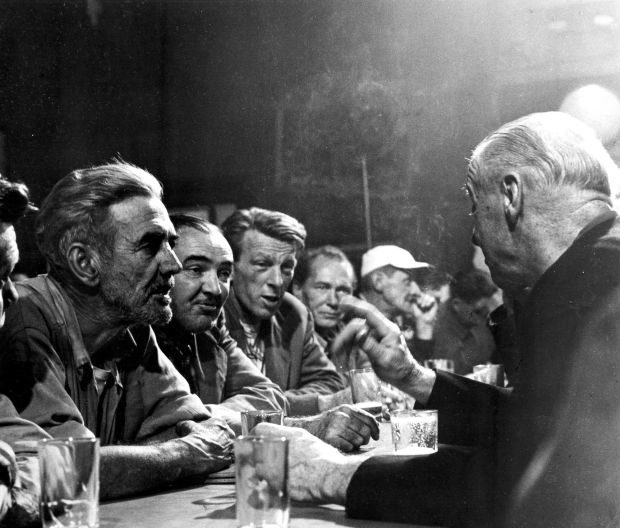
Lionel Rogosin’s 1956 portrait of the Skid Row neighborhood in lower Manhattan was a startling new development in American cinema.
On the Bowery is a fascinating documentary film from 1956, by Lionel Rogosin, examining the lives of destitute alcoholics living in the Bowery neighborhood on lower Manhattan, commonly known as “Skid Row.”
Rogosin was a native New Yorker, the son of a wealthy philanthropist, who taught himself how to film with a 16 millimeter camera. Living in Greenwich Village, near the Bowery, he decided in 1955 to try to make a movie about this place of poverty and desperation, producing it with 65 thousand dollars of his own money. The wispiest of plots was used as a pretext for a lot of amazing real-life footage, shot in the bars, streets, and flophouses, often with a hidden camera. The story elements have led to On the Bowery being labeled as “docufiction,” and this also caused American critics at the time to attack the film as inauthentic, but a viewer today can easily see that the plot and dialogue blend seamlessly with actual behavior and conditions.
The story concerns a man named Ray, younger than the usual inhabitant of the Bowery, who shows up there after a stint working on the railroad in New Jersey, and is befriended by an older man named Gorman. Ray has a suitcase full of old clothes he plans on selling, but that gets stolen when he’s in a black-out, and after a few binges he tells Gorman he wants to quit drinking.
These were not actors. Ray was Ray Salyer, an actual railroad worker that Rogosin ran into after Ray had spent the weekend on a bender. Gorman was Gorman Hendricks, a long-time Bowery resident. The window that Rogosin opens onto this hellish life is compelling.
The men (the drunks are almost all male) support their habit by working at occasional day labor, making enough for some drinks and a flop. Or they cadge money or drinks from others and, in some cases, steal. Most of them sleep on the street. The rawness of the barroom scenes, in which the men yell, carouse, argue and fight as they get more drunk, is unforgettable. Also remarkable is a sequence in which Ray enters a gospel mission, where he gets a hot meal in exchange for listening to a sermon. There are no cots here, just the hard floor, but at least it’s inside. The notion that alcoholism is a moral issue that can be solved by religion is shown to be pretty empty—there’s no mention of AA, which by the time of the film had been around for quite a while, but was still a lot smaller than it is today.
Eventually during the filming, Rogosin had to get a permit from the city because the cops kept stopping him and his crew for questioning, and arresting the drunks, who would come back from jail with shaves and haircuts that didn’t match the previous footage. It took five months to shoot the picture, during which the Bowery residents became completely comfortable with the film crew, behaving with a naturalness that is rare in any documentary. And in a tragic footnote, the two leads, Salyer and Hendricks, eventually died from their disease.
It’s hard to imagine nowadays how different On the Bowery was from any other film that had ever been made. The rawness and unpleasantness of the reality being shown were shocking to those accustomed to the slick Hollywood product of the 1950s. The film did garner awards at Venice and London, and to the great credit of the Academy, it was also nominated for an Oscar in the documentary category.
There were other artists paying close attention, including John Cassavetes and Shirley Clarke, both inspired by Rogosin to forge new paths for independent and documentary film. Seen today, On the Bowery still possesses a brutal and visceral power. It’s available in streaming format and on DVD.

In the late 19th century, a Danish Lutheran priest is sent to Iceland to build a church, but the overwhelming power of nature threatens...

Jean-Pierre Melville, a French director who loved America and its cinema so much that he changed his last name to that of the author...

Tom Cruise stars as a real-life pilot who got caught up and in the dangerous, but lucrative, business of running weapons and cocaine in...